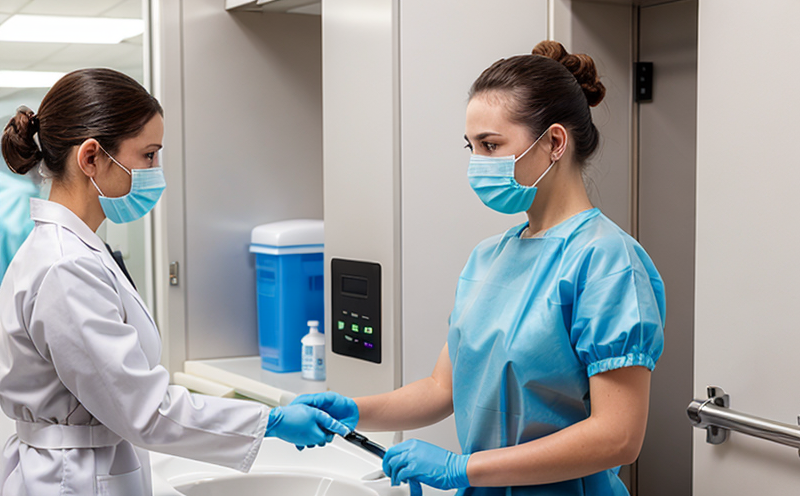Assessment of hygiene properties in sportswear fabrics
The assessment of hygiene properties in sportswear fabrics is crucial for ensuring that garments meet both consumer expectations and regulatory requirements. Hygiene properties encompass a range of characteristics, including the ability to resist microbial growth, absorb moisture, provide thermal regulation, and maintain freshness during prolonged use.
Textile testing laboratories employ advanced methodologies to evaluate these properties, providing detailed reports that help manufacturers improve product quality and enhance consumer satisfaction. This service is particularly important in the sportswear sector, where consumers often spend extended periods of time wearing their clothing, increasing the risk of microbial contamination and odor buildup.
One key aspect of this assessment involves the use of ISO 20743:2016, which provides guidelines for antimicrobial activity in textiles. This standard is widely recognized and utilized by industries focused on hygiene and performance. Another important standard, ASTM D6869-16, addresses the measurement of moisture management properties, ensuring that fabrics perform effectively under various environmental conditions.
The process typically begins with specimen preparation, where samples are cut from the fabric to ensure they represent the entire product. The specimens undergo a series of tests designed to simulate real-world conditions and assess their performance. These include:
- Moisture absorption tests using ASTM D5709-14
- Bacterial reduction tests following ISO 20743:2016
- Microbial growth inhibition tests adhering to EN 16873:2018
Once the specimens have been tested, detailed reports are generated. These reports outline the results of each test and provide recommendations for improvement where necessary. The data collected during these assessments can be used by R&D engineers to refine future product designs, ensuring that new fabrics meet or exceed current industry standards.
The competitive advantage gained from rigorous hygiene property testing is substantial. Brands can differentiate themselves in the marketplace by offering products that are not only functional but also hygienic, which is particularly appealing to health-conscious consumers. Additionally, compliance with international standards such as ISO and ASTM enhances brand reputation and helps avoid potential legal issues.
In conclusion, the assessment of hygiene properties in sportswear fabrics is an indispensable service for ensuring product quality and meeting consumer needs. By adhering to established standards and using advanced testing methodologies, laboratories can provide clients with reliable data that supports informed decision-making and continuous improvement in their product development processes.
Why It Matters
The importance of assessing hygiene properties in sportswear fabrics cannot be overstated. Consumers expect their clothing to remain fresh, odour-free, and free from harmful microorganisms during extended wear, especially when engaging in physical activities that generate heat and moisture.
From a practical standpoint, poor hygiene performance can lead to discomfort for the wearer, which may result in reduced customer satisfaction and even product returns. Moreover, non-compliance with relevant standards could expose brands to legal challenges or negative publicity, damaging their reputation.
In terms of brand perception, products that consistently meet high hygiene standards are perceived as superior quality, often leading to increased consumer loyalty and higher sales volumes. This is particularly true for premium sportswear brands that cater to health-conscious consumers who prioritize product performance and safety.
From a regulatory perspective, adherence to established standards ensures compliance with local and international regulations, thereby minimizing the risk of legal action or fines. For manufacturers, this service offers valuable insights into how their products perform under realistic conditions, enabling them to make informed decisions about material selection and manufacturing processes.
Applied Standards
In line with industry best practices, our laboratory adheres strictly to international standards when evaluating the hygiene properties of sportswear fabrics. These include:
- ISO 20743:2016 - This standard specifies requirements for antimicrobial activity in textiles, ensuring that materials effectively inhibit microbial growth.
- ASTM D6869-16 - This document provides a method for measuring the moisture management properties of fabrics, which is crucial for maintaining comfort during physical activities.
- EN 16873:2018 - This European standard outlines procedures for determining the antibacterial and antifungal properties of textile materials, providing a comprehensive approach to hygiene testing.
The use of these standards ensures that our assessments are rigorous and consistent with industry norms, thereby enhancing the reliability and validity of our test results. Our clients can be assured that their products will meet or exceed international quality benchmarks, which is essential for maintaining a competitive edge in the global market.
Competitive Advantage and Market Impact
The ability to assess hygiene properties effectively provides significant competitive advantages. Brands that consistently deliver products with superior hygienic performance are more likely to attract and retain customers, thereby driving brand loyalty and sales growth.
In a market where consumer awareness of health and wellness is increasing, brands that can demonstrate their commitment to product safety and quality through rigorous testing will be perceived favorably. This not only enhances the reputation of individual products but also contributes positively to the overall image of the brand.
From a strategic standpoint, investing in such services allows companies to stay ahead of regulatory changes and emerging trends. By adhering to international standards and staying abreast of new testing methodologies, they can ensure that their products remain relevant and appealing to discerning consumers.
The data generated from these assessments also provides valuable insights into areas for improvement within the supply chain. For instance, understanding which materials perform best under specific conditions allows manufacturers to optimize production processes and source higher-quality raw materials. This leads to improved product quality, reduced waste, and cost savings across the entire operation.
In summary, the assessment of hygiene properties in sportswear fabrics is not just a compliance requirement but also a strategic initiative that supports long-term business success by enhancing brand reputation, driving sales growth, and ensuring regulatory compliance.





